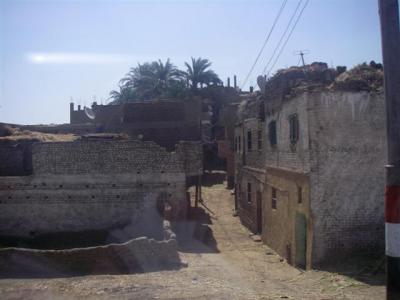The alarm went off at 0300, which was painful. At 0400, we were in the lobby of the hotel, waiting for the bus to pick us up. We told our French friends about the tour, and they decided to come too. 5 minutes later, we were on our way. The bus was really nice, with comfy seats. We followed the coast north to a town called Safaga, stopping to pick up people along the way. In Safaga, we joined a convoy of 70 tourist busses, all going to Luxor. There have been issues with terrorist attacks against tourists in the past in Egypt, so the government requires that all tour groups travel in a police escorted convoy through the desert. At 0730, the convoy pulled out, heading east towards the mountains.
The mountains are as dry and barren of life as the coast. For part of the way, there wasn’t even any scrubby little desert plants around. The mountains look very unstable, like soft rock that easily breaks apart. In some places, the mountains are large solid boulders, but in other places, it looks like the boulders have eroded into piles of rocks and dirt.
Around 1000, we reached the Nile valley and turned to follow the river. The guide explained to us that in Upper Egypt, people were still very traditional and followed the old, customary way of life. The people are still farmers, and they have very few modern tools to farm with, preferring farming by hand. Houses are made from mud brick with ceilings made of plant stalks. Houses ranged in size from one room, one story to very large three stories. Apparently, as the family grows, they just add more rooms/stories to the existing house. Despite the old fashioned ways, virtually all the houses had satellite dishes on the roofs. Few women were out, and all wore the black robes and black head scarves. There were lots of men out, and all were dressed in what look like old fashioned pajama dresses that go to the ankles and are long sleeved. The land was all farmland dotted with clusters of houses and the occasional mosque. It looks like they grow a large variety of produce.

At 1100, we rolled into Luxor. From what we could see, Continue reading →
